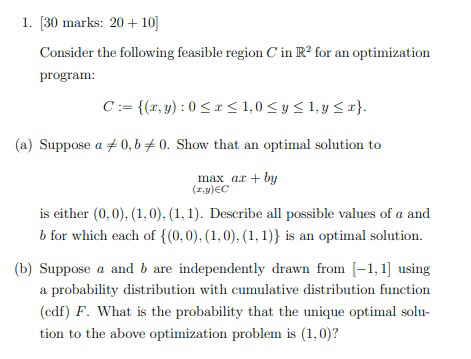Consider the feasible region $C = \{(x, y) : 0 \leq x \leq 1, 0 \leq y \leq 1, y \leq x\}$. (a) Suppose $a \neq 0, b \neq 0$. Show that an optimal solution to $\max_{(x,y) \in C} a... Consider the feasible region $C = \{(x, y) : 0 \leq x \leq 1, 0 \leq y \leq 1, y \leq x\}$. (a) Suppose $a \neq 0, b \neq 0$. Show that an optimal solution to $\max_{(x,y) \in C} ax + by$ is either (0,0), (1,0), or (1,1). Describe all possible values of $a$ and $b$ for which each of $\{(0,0), (1,0), (1, 1)\}$ is an optimal solution. (b) Suppose $a$ and $b$ are independently drawn from [-1,1] using a probability distribution with cumulative distribution function (cdf) F. What is the probability that the unique optimal solution to the above optimization problem is (1,0)?

Understand the Problem
The question presents an optimization problem with a feasible region $C$ defined in $R^2$. Part (a) requires proving that the optimal solution to maximizing $ax + by$ within $C$ must be one of the points (0,0), (1,0), or (1,1), and then characterizing the values of $a$ and $b$ for which each of these points is optimal. Part (b) asks for the probability that (1,0) is the unique optimal solution when $a$ and $b$ are independently drawn from the interval [-1, 1] with a given cumulative distribution function F.
Answer
(a) Optimal solutions are among vertices (0,0), (1,0), (1,1). (0,0) optimal if $a < 0$ and $a+b < 0$, (1,0) optimal if $a > 0$ and $b < 0$, (1,1) optimal if $b > 0$ and $a+b > 0$. (b) $\frac{1}{4}$
Answer for screen readers
(a) An optimal solution must be one of (0,0), (1,0), or (1,1) because the feasible region is convex and the objective function is linear.
- (0,0) is optimal if $a < 0$ and $a + b < 0$.
- (1,0) is optimal if $a > 0$ and $b < 0$.
- (1,1) is optimal if $b > 0$ and $a + b > 0$.
(b) The probability that (1,0) is the unique optimal solution is $\frac{1}{4}$.
Steps to Solve
- Understanding the feasible region
The feasible region $C$ is a triangle defined by the vertices (0,0), (1,0), and (1,1). This region is a subset of the unit square where $y \leq x$.
- Evaluating the objective function at the vertices
The objective function is $ax + by$. Evaluate this function at each vertex of the feasible region:
- At (0,0): $a(0) + b(0) = 0$
- At (1,0): $a(1) + b(0) = a$
- At (1,1): $a(1) + b(1) = a + b$
- Showing optimality at the vertices
Since $C$ is a convex set and the objective function is linear, the maximum value must occur at one of the vertices. Thus, the optimal solution must be one of (0,0), (1,0), or (1,1).
- Characterizing when (0,0) is optimal
(0,0) is optimal if $0 > a$ and $0 > a+b$. This is equivalent to $a < 0$ and $a + b < 0$.
- Characterizing when (1,0) is optimal
(1,0) is optimal if $a > 0$ and $a > a+b$. This is equivalent to $a > 0$ and $b < 0$.
- Characterizing when (1,1) is optimal
(1,1) is optimal if $a+b > 0$ and $a+b > a$. This is equivalent to $a+b > 0$ and $b > 0$.
- Solving part (b): Probability of (1,0) being the unique optimal solution
For (1,0) to be the unique optimal solution, we need $a > 0$, $b < 0$, $a > a+b$ (which simplifies to $b < 0$), $a > 0$ and to ensure it's unique, we want $a+b < a$ and $0 < a$. The conditions are therefore $a > 0$ and $b < 0$. Since $a$ and $b$ are independently drawn from [-1,1], the probability density function for each is $f(x) = 1/2$ for $-1 \le x \le 1$. The probability that $a > 0$ is $\int_0^1 \frac{1}{2} da = \frac{1}{2}$. The probability that $b < 0$ is $\int_{-1}^0 \frac{1}{2} db = \frac{1}{2}$. Since $a$ and $b$ are independent, the probability that $a > 0$ and $b < 0$ is $\frac{1}{2} \times \frac{1}{2} = \frac{1}{4}$.
(a) An optimal solution must be one of (0,0), (1,0), or (1,1) because the feasible region is convex and the objective function is linear.
- (0,0) is optimal if $a < 0$ and $a + b < 0$.
- (1,0) is optimal if $a > 0$ and $b < 0$.
- (1,1) is optimal if $b > 0$ and $a + b > 0$.
(b) The probability that (1,0) is the unique optimal solution is $\frac{1}{4}$.
More Information
Part (a) uses the property that the maximum of a linear function over a convex set is attained at a vertex. Part (b) relies on the independence of the random variables $a$ and $b$ and basic probability calculations.
Tips
A common mistake may be forgetting that since the feasible region is a closed, bounded set and the objective function is continuous, an optimal solution must exist. Another common mistake is not considering the uniqueness condition in part (b).
AI-generated content may contain errors. Please verify critical information